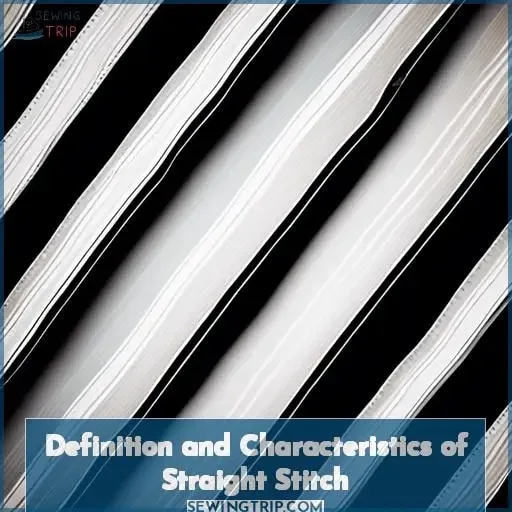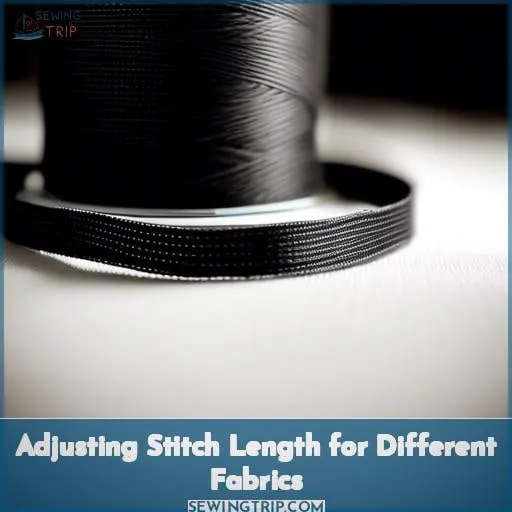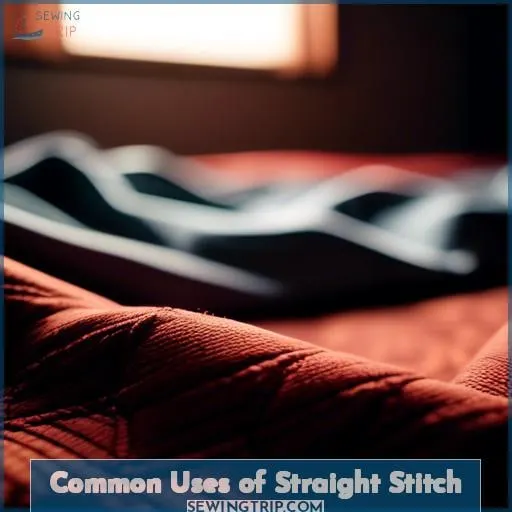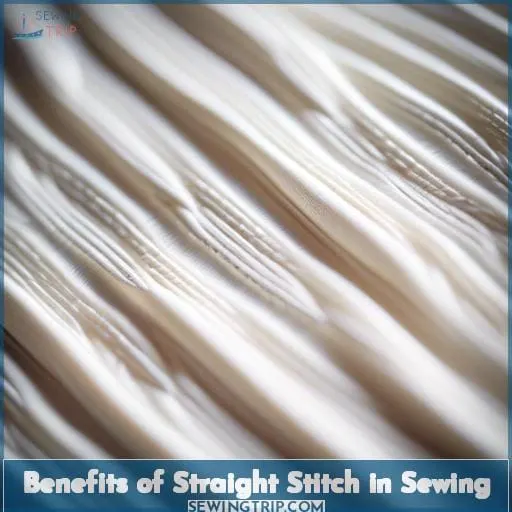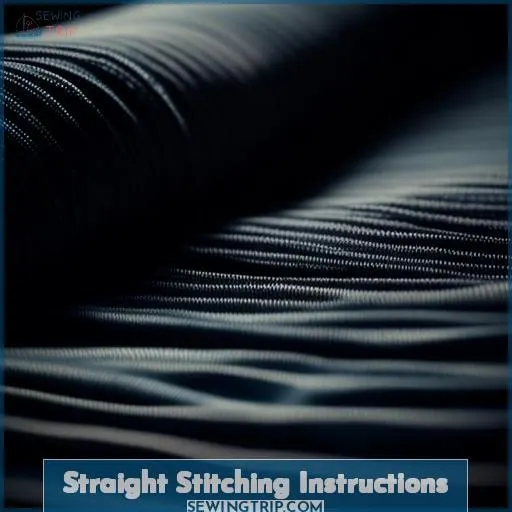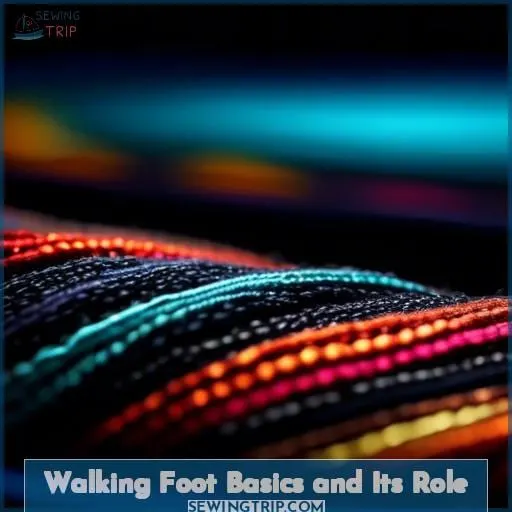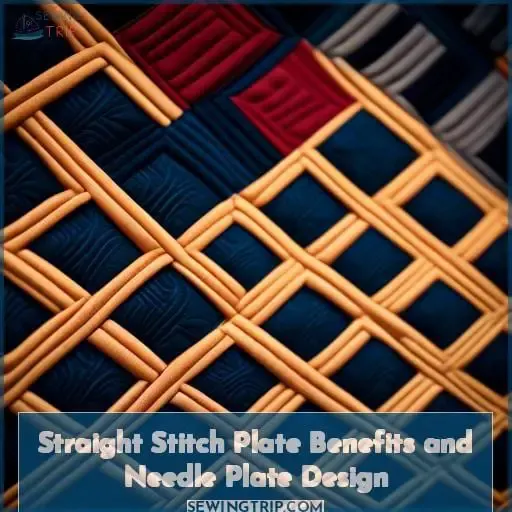This site is supported by our readers. We may earn a commission, at no cost to you, if you purchase through links.
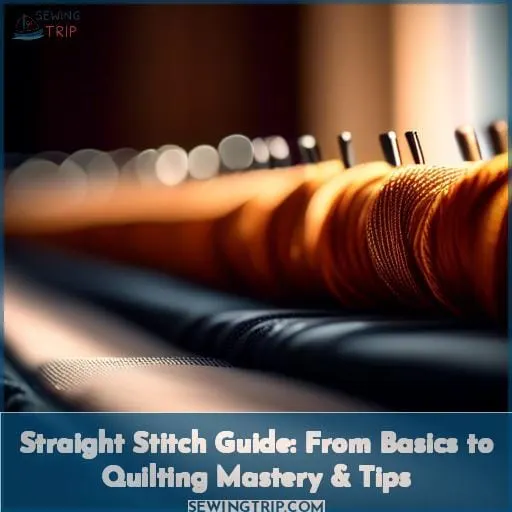
You’ll discover how this fundamental technique can be your go-to for a myriad of projects. Whether you’re piecing together a cozy quilt or adding the finishing touches with topstitching, mastering the straight stitch opens up a world of possibilities.
Let’s unravel the thread of this essential skill and stitch your way to sewing success.
Table Of Contents
- Key Takeaways
- What is a Straight Stitch Used For
- Definition and Characteristics of Straight Stitch
- Adjusting Stitch Length for Different Fabrics
- Common Uses of Straight Stitch
- Benefits of Straight Stitch in Sewing
- Straight Stitching Instructions
- Walking Foot Basics and Its Role
- Exploring Decorative Stitches With a Walking Foot
- Straight Stitch Plate Benefits and Needle Plate Design
- Quilting Techniques With Straight Stitch
- Frequently Asked Questions (FAQs)
- Conclusion
Key Takeaways
- The straight stitch is versatile and used for construction sewing, machine quilting, topstitching, gathering, and basting, making it essential for a wide range of sewing projects.
- Adjusting the stitch length according to the fabric thickness and type can optimize the strength and appearance of the seam, with thicker materials requiring longer stitches.
- The straight stitch is known for its strength and reliability, providing durable seams and stitches that are less likely to unravel, while also being efficient in thread consumption.
- Proper setup and practice with straight stitching, including selecting the right fabric, adjusting tension, and using appropriate tools like a walking foot, can significantly improve the quality of sewing projects.
What is a Straight Stitch Used For
A straight stitch is used for basic hand-sewing and embroidery, forming the foundation for all other sewing techniques by varying its length, spacing, and direction. It’s also essential in machine sewing for constructing garments, quilting, and decorative purposes, proving to be versatile and strong.
Definition and Characteristics of Straight Stitch
Dive into the world of sewing with the straight stitch, your trusty sidekick for nearly every project you’ll tackle. Think of it as the Swiss Army knife in your sewing toolkit. This stitch is the backbone of your creations, interlocking needle and bobbin threads in a dance of durability and simplicity.
Whether you’re piecing together a quilt or stitching up a storm on a new garment, the straight stitch is your go-to.
But don’t let its simplicity fool you. Mastering the straight stitch involves a symphony of elements: thread tension, needle selection, and the right choice of fabric types. Each plays a pivotal role in achieving that perfect stitch density that holds your project together.
And let’s not forget about the versatility of reverse sewing and the lock stitch for those strong starts and finishes.
Adjusting the speed can turn quilting into a breeze or a precision task, depending on your project’s needs. And with the right accessories, like a walking foot or a straight stitch plate, you’re equipped to tackle anything from delicate fabrics to multiple layers.
Remember, the straight stitch might be basic, but it’s your canvas for creativity and innovation in sewing.
Adjusting Stitch Length for Different Fabrics
Adjusting stitch length for different fabrics is like tuning a guitar for a perfect melody. It’s all about finding that sweet spot where everything harmonizes. Whether you’re working with a mechanical sewing machine or a more modern model, the principles remain the same.
- Consider fabric thickness: Thicker materials might sing better with a longer stitch, while delicate fabrics prefer a shorter, more discreet stitch.
- Thread choice matters: Pair your fabric with the right thread. A mismatch could lead to a performance that’s off-key.
- Tension settings are key: Just like in a band, balance is crucial. Adjust the tension to ensure your stitches aren’t too tight or too loose.
- Needle size and material weight: Using the correct needle for your fabric weight ensures your machine doesn’t skip a beat.
Common Uses of Straight Stitch
You’ll find the straight stitch to be a versatile tool in your sewing arsenal. It’s perfect for construction sewing, machine quilting, topstitching, and even gathering and basting. This stitch is essential for creating strong, durable seams and decorative finishes on a wide range of projects.
Construction Sewing
After mastering stitch length, dive into construction sewing, where your straight stitch machine becomes your best ally.
Consider seam allowances, fabric density, and stitch tension. Choose your thread and needle wisely.
Use the thread guide bar and aim for a ¼″ seam allowance. Don’t forget the needle-down button for precision.
Machine Quilting
Dive into machine quilting with a straight stitch and watch your projects transform.
- Use a walking foot for even fabric tension.
- Experiment with decorative thread for a pop.
- Adjust stitch density and tension for perfect seams.
- Try a triple straight stitch for extra strength.
- Swap to a free-motion quilting foot for curved quilting.
Topstitching
After mastering machine quilting, let’s dive into topstitching. This technique elevates your projects with topstitching details and contrast.
Adjust the foot pressure and use the thread plate for precision. Don’t forget the automatic thread cutter for clean finishes.
Topstitch embellishments and patterns bring your seams to life, showcasing your sewing prowess.
Gathering and Basting
When you’re gathering fabric or basting materials, think of your sewing machine as a trusty sidekick.
Use a long thread and set for a straight stitch, leaving a generous seam allowance.
These short seams are your secret weapons for holding layers together—no sweat, just smooth sewing!
Benefits of Straight Stitch in Sewing
You’ll find that the straight stitch’s strength and reliability make it a cornerstone of sewing projects.
Its versatility and efficiency in thread use open up a wide range of applications, from basic seams to intricate quilting.
Strength and Reliability
Dive into the fabric of sewing with straight stitch, your go-to for strength and reliability.
Imagine it as the backbone of your creations, where stretch stitches and bias seams fear to tread.
With the right tension settings and a precise needle drop, every backstitch and bobbin dance ensures your project stays intact.
Don’t just sew; weave durability into your quilt piecing and stay stitches, mastering the art with every pin feed mechanism whirl.
Reduced Thread Consumption
After diving into the strength and reliability of the straight stitch, let’s thread our way to another perk: thread efficiency.
A straight stitch is a real thread saver, especially when you’re on a tight sewing budget. By adjusting the stitch length and feed dog settings, you can optimize thread use without compromising seam strength, whether you’re working with thin fabrics or tackling thicker layers.
This approach not only stretches your thread further but also ensures your seams are sturdy and durable. So, whether you’re easing into an ease stitch or doubling down with a double needle, remember that a straight stitch keeps your thread in check and your fabric firmly together.
Versatile Stitch Applications
- Quilting Machine Marvel: Straight stitch makes quilting a breeze, laying down precise lines that turn fabric into art.
- Decorative Dynamo: Beyond the basics, use it for edge stitching or blend with zigzag and buttonhole stitches for flair.
- Fabric Friendly: Ideal for knit fabrics, reinforcing pant crotches, and securing armhole seams with confidence.
Embrace the straight stitch; it’s your secret weapon in the sewing arsenal!
Straight Stitching Instructions
After diving into the benefits of straight stitch, let’s roll up our sleeves and get into the nitty-gritty of straight stitching instructions. You’re about to become a straight stitch whiz, threading your needle with confidence and winding your bobbin like a pro.
First off, selecting the right fabric is crucial. Whether you’re aiming for the delicate art of sashiko stitching or the durability of a triple zigzag, your fabric choice sets the stage. Adjusting tension is like tuning a guitar; get it just right, and your stitches will sing.
And don’t forget about seam finishing – it’s the cherry on top of your sewing sundae.
Here’s a quick table to guide you through the essentials:
| Step | Key Point |
|---|---|
| Needle threading | The gateway to starting your project. |
| Bobbin winding | Powering your stitch from below. |
| Tension adjusting | Fine-tune for smooth, even stitches. |
| Fabric selection | Match your project to the perfect material. |
| Seam finishing | Polish off with a professional touch. |
Speed control on your high-speed sewing machine is your best friend, especially when navigating through different fabric thicknesses. Remember, practice makes perfect, and soon you’ll be stitching with the ease and grace of a seasoned pro.
Walking Foot Basics and Its Role
Diving into the world of sewing, let’s chat about the unsung hero of your sewing machine: the walking foot. This nifty attachment is like having an extra pair of hands, ensuring your layers of fabric glide through your machine as smoothly as butter on a hot skillet.
- Gentle Curves Are a Breeze: Forget about puckering and pleating; the walking foot handles gentle curves like a pro, making your quilts look effortlessly elegant.
- Decorative Stitches? Yes, Please!: While primarily known for its prowess with straight stitches, don’t be shy to experiment with decorative stitches. Just remember, it’s a bit like dancing in a bulky suit of armor; proceed with caution.
- Limitations, Schlimitations: Sure, the walking foot might seem like a one-trick pony with its straight stitch mantra, but its capabilities in free-motion quilting and handling tricky fabrics will have you singing its praises.
- Built to Last: With its metal construction and hands-free knee lift, this attachment isn’t just a tool; it’s a durable companion in your sewing journey.
So, whether you’re quilting a masterpiece or adding some flair with decorative stitches, remember: the walking foot is your steadfast ally, ready to tackle any project with grace and precision.
Exploring Decorative Stitches With a Walking Foot
When you’re quilting with a walking foot, you’re not limited to the straight and narrow.
Before you dive in, check your machine compatibility—some walking feet are straight stitch only, while others can tango with a variety of stitches. And remember, challenging fabrics that usually give you the slip will behave much better under the guidance of a walking foot.
Here’s a quick table to guide you through the possibilities:
| Stitch Type | Use Case | Thread Type |
|---|---|---|
| Feather Stitch | Adds flair to hems | Polyester Embroidery Thread |
| Vine Stitch | Decorative topstitching | Polyester Embroidery Thread |
| Mock Hand Quilt | Quilting that pops | Polyester Embroidery Thread |
| Straight Stitch | Reliable seams | Polyester Embroidery Thread |
When turning walking foot corners, think of it as easing into a curve rather than a sharp pivot. It’s like steering a boat—anticipate the turn and glide through. With these quilting techniques, you’ll be stitching up a storm, leaving puckering and bunching in your wake.
Straight Stitch Plate Benefits and Needle Plate Design
You’ll find that using a straight stitch plate can significantly enhance your precision piecing. It provides a stable base that prevents fabric from slipping. The plate is designed to improve fabric support under the needle, which is especially beneficial for free-motion quilting.
Enhanced Precision Piecing
Transitioning from decorative stitches to precision piecing, you’ll find the straight stitch plate is your secret weapon.
- Straight stitch plate boosts your machine piecing game, ensuring quarter-inch seams are spot-on.
- It’s a game-changer for free-motion quilting, supporting fabric for smooth sailing.
- Expect a leap in stitch quality; think of it as upgrading from a sedan to a sports car in the sewing world.
Fabric Support Improvement
When you’re quilting with gusto, a straight stitch plate is your secret weapon. It’s like having a backstage pass to flawless seams. This nifty plate, with its teeny needle hole, keeps your fabric from taking a nosedive into the abyss of your machine.
It’s the unsung hero that, paired with a walking foot, turns free-motion quilting into a smooth dance, ensuring your fabric support is rock solid.
| Benefits | Emotional Response |
|---|---|
| Enhanced Precision | Like hitting the bullseye every time! |
| Fabric Support | Your fabric’s knight in shining armor. |
| Extension Table Compatibility | Spreading wings on a tiny runway. |
| Needle Plate Design | The guardian of your stitch kingdom. |
Free-Motion Quilting Support
Transitioning from fabric support improvement, let’s dive into the world of free-motion quilting support. This technique elevates your quilting game, ensuring your creations aren’t just beautiful but structurally sound.
- Enhance fabric support for smooth quilting
- Achieve piecing accuracy with precision
- Notice a significant free-motion improvement
- Master the art of binding attachment effortlessly
- Enjoy knit flexibility in your projects
Quilting Techniques With Straight Stitch
When it comes to quilting techniques with a straight stitch, you’ll find it’s a versatile tool for free-motion quilting. It is also useful for attaching binding and sewing stretch knits. Mastering these applications can elevate your quilting projects, offering both strength and aesthetic appeal.
Free-Motion Quilting
Transitioning from the straight stitch plate’s precision, let’s dive into free-motion quilting. This technique allows you to create custom quilting designs and machine-stitched embellishments with ease.
Think of your fabric as a canvas for unique quilt patterns and fabric manipulation techniques.
| Emotion | Why It Matters |
|---|---|
| Excitement | Unleash creativity |
| Pride | Personal masterpieces |
| Curiosity | Explore new techniques |
Embrace this journey to stitch your story.
Attaching Binding
Dive into the art of attaching binding with your trusty straight stitch.
Think of it as wrapping a gift; your fabric’s edge is the present, and the binding is your decorative paper.
Opt for bias binding for its stretch and flexibility, perfect for those curvy edges.
Use a double fold for extra durability.
Fold your fabric precisely, stitch close to the edge, and voilà, a masterpiece is born.
Sewing Stretch Knits
Transitioning from attaching binding to sewing stretch knits, you’ll find straight stitch surprisingly adept.
- Choose ballpoint needles to prevent snags.
- Pre-wash fabric to avoid post-sewing shrinkage.
- Adjust tension to prevent puckering.
- Select a walking presser foot for even feeding.
- Finish seams with a zigzag stitch for flexibility.
Master these steps, and you’ll be stitching stretch knits like a pro in no time!
Frequently Asked Questions (FAQs)
Can straight stitch be used for embroidery?
Yes, you can use a straight stitch for embroidery to create various patterns like leaves, flowers, or geometric designs.
Is straight stitch suitable for stretch fabrics?
Straight stitch isn’t your go-to for stretch fabrics. It lacks the give your stretchy creations crave.
Instead, opt for a zigzag or stretch stitch to keep seams from snapping when they’re put to the test.
How does straight stitch affect fabric drape?
Like a tightrope walker, a straight stitch holds fabric with precision. It creates seams that resist stretching, maintaining the fabric’s natural drape without warping its graceful fall.
Can straight stitch prevent fabric fraying?
Straight stitch can’t fully stop fabric from fraying; it’s like trying to hold water in your hands.
For a real fray-fighting hero, zigzag or overlock stitches are your go-to, wrapping those edges up tight.
What tension settings are best for straight stitch?
For straight stitch perfection, aim for a tension setting around
This sweet spot ensures your stitches are neither too tight nor too loose, making every seam a masterpiece in the fabric of your creations.
Conclusion
As you thread your needle and embark on your sewing journey, remember that the straight stitch is your steadfast ally. It’s essential for constructing durable seams, quilting with precision, adding elegant topstitching, and even creating gathers with ease.
Embrace this versatile stitch to reduce thread use and ensure strong, reliable results. Keep practicing, and you’ll find that straight stitching is the cornerstone of countless sewing projects, helping you achieve a professional finish every time.

